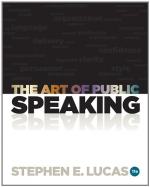34. Deliver a short appeal to men to give up some evil way.
35. Criticise the structure of the sentence beginning with the last line of page 296.
CHAPTER XXV
INFLUENCING THE CROWD
Success in business, in the last analysis, turns upon touching the imagination of crowds. The reason that preachers in this present generation are less successful in getting people to want goodness than business men are in getting them to want motorcars, hats, and pianolas, is that business men as a class are more close and desperate students of human nature, and have boned down harder to the art of touching the imaginations of the crowds.
—GERALD STANLEY LEE, Crowds.
In the early part of July, 1914, a collection of Frenchmen in Paris, or Germans in Berlin, was not a crowd in a psychological sense. Each individual had his own special interests and needs, and there was no powerful common idea to unify them. A group then represented only a collection of individuals. A month later, any collection of Frenchmen or Germans formed a crowd: Patriotism, hate, a common fear, a pervasive grief, had unified the individuals.
The psychology of the crowd is far different from the psychology of the personal members that compose it. The crowd is a distinct entity. Individuals restrain and subdue many of their impulses at the dictates of reason. The crowd never reasons. It only feels. As persons there is a sense of responsibility attached to our actions which checks many of our incitements, but the sense of responsibility is lost in the crowd because of its numbers. The crowd is exceedingly suggestible and will act upon the wildest and most extreme ideas. The crowd-mind is primitive and will cheer plans and perform actions which its members would utterly repudiate.
A mob is only a highly-wrought crowd. Ruskin’s description is fitting: “You can talk a mob into anything; its feelings may be—usually are—on the whole, generous and right, but it has no foundation for them, no hold of them. You may tease or tickle it into anything at your pleasure. It thinks by infection, for the most part, catching an opinion like a cold, and there is nothing so little that it will not roar itself wild about, when the fit is on, nothing so great but it will forget in an hour when the fit is past."[28]
History will show us how the crowd-mind works. The medieval mind was not given to reasoning; the medieval man attached great weight to the utterance of authority; his religion touched chiefly the emotions. These conditions provided a rich soil for the propagation of the crowd-mind when, in the eleventh century, flagellation, a voluntary self-scourging, was preached by the monks. Substituting flagellation for reciting penitential psalms was advocated by the reformers. A scale was drawn up, making one thousand strokes equivalent




